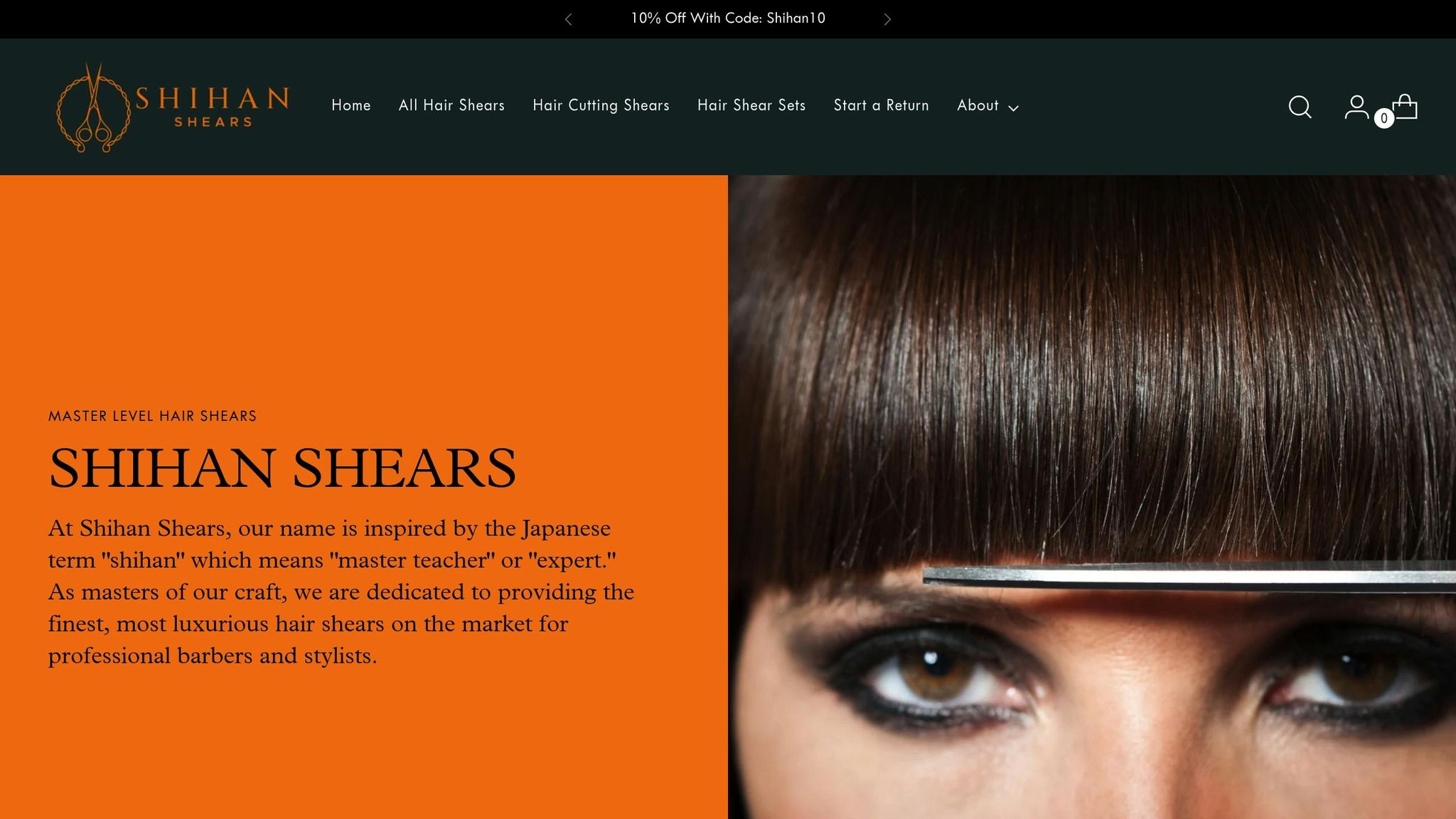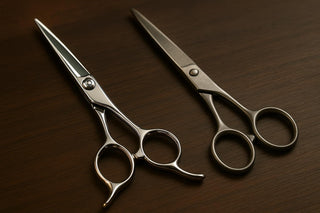Why does Japanese steel outperform others? It’s all about composition and heat treatment. Japanese steel grades like VG-10, ZA-18, and ATS-314 combine precise amounts of carbon and alloy, creating tools that are sharp, durable, and resistant to wear. Advanced heat treatment methods, such as the Japanese clay-coating process (yakiba-tsuchi), enhance these properties further, making it the gold standard for professional hairstyling tools.
Key Takeaways:
- Japanese Steel Advantages: Superior sharpness, edge retention, flexibility, and corrosion resistance.
- Heat Treatment: Japanese methods like clay-coating create targeted hardness and durability, unlike uniform Western techniques.
- Professional Tools: Products like Shihan Shears’ Red Moon Set showcase the unmatched performance of heat-treated VG-10 steel.
Quick Comparison:
| Feature | Japanese Steel (VG-10) | Other Steel Types |
|---|---|---|
| Sharpness | Excellent, long-lasting | Moderate, dulls faster |
| Edge Retention | Superior | Standard |
| Heat Treatment | Clay-coating for precision | Uniform, less precise |
| Corrosion Resistance | High | Moderate to low |
| Flexibility | Balanced | Often brittle or too soft |
Explore how Japanese steel’s unique heat treatment methods deliver unmatched performance for hairstyling professionals.
Heat treated of Japanese knife steel treating by Shokei Funaki
Heat Treatment Methods: Japanese vs Other Steel Types
The way steel is heat-treated plays a major role in its performance, and Japanese techniques stand apart from other methods due to their unique approach.
Japanese Clay-Coating Process
The Japanese clay-coating process, known as yakiba-tsuchi, is a specialized heat treatment method. It involves applying a specific clay mixture to select parts of the steel before quenching. For high-end Japanese steels like VG-10 - used in tools such as the Shihan Shears Red Moon Set - this technique creates an ideal mix of hardness at the edge and flexibility in the spine.
By controlling the cooling rate during quenching, this process achieves:
- Targeted hardness distribution
- Excellent edge retention
- Enhanced durability
- Improved wear resistance
Standard Western Methods
Western heat treatment methods, on the other hand, rely on uniform processes that deliver consistent results across the entire steel piece. While efficient for large-scale production, these techniques often lack the precision of Japanese methods.
| Method | Characteristics | Typical Applications |
|---|---|---|
| Oil Quenching | Produces uniform hardness | General-purpose tools |
| Air Cooling | Results in moderate hardness | Industrial equipment |
| Batch Processing | Ensures standardized results | Mass-produced items |
Although effective, these approaches differ significantly from the more intricate Japanese techniques.
Modern Japanese Techniques
Today, Japanese steelmaking blends traditional craftsmanship with cutting-edge technology. Premium steel grades like VG-10, ZA-18, and ATS-314 are treated with advanced processes that further enhance their natural qualities.
This combination of tradition and innovation results in steel with exceptional performance, making it a top choice for professional tools. Products like the Shihan Shears Red Moon Set demonstrate this balance of hardness and flexibility, making them perfect for demanding tasks like professional hairstyling.
Steel Performance Comparison
Heat treatment plays a key role in shaping the performance of steel. Through careful heat treatment processes, Japanese steel achieves a level of quality that stands out compared to standard options.
Sharpness Testing
VG-10 stainless steel is known for its ability to hold an edge for extended periods, even with heavy professional use. This sharpness is paired with a well-balanced flexibility, making it ideal for precise cutting tasks. A great example of this is the Shihan Shears' Red Moon Set, crafted from VG-10 steel.
Strength vs. Flexibility
VG-10 stainless steel strikes an excellent balance between strength and flexibility, making it both durable and precise. The Shihan Shears' Red Moon Set showcases this combination, offering consistent and reliable cutting performance.
Rust Prevention
One standout feature of VG-10 stainless steel is its resistance to corrosion, which is essential for daily use in environments with high humidity or frequent exposure to products. Shihan Shears ensures their products, like the Red Moon Set, are built to perform dependably under such conditions.
sbb-itb-a50b05d
Professional Hair Shear Requirements
Why Japanese Steel Matters for Shears
Professional shears demand top-tier materials to handle the rigors of daily use. Japanese steel, particularly the VG-10 grade, stands out for its combination of hardness and flexibility. This balance is achieved through precise heat treatment, making it ideal for professional hairstylists.
| Property | Advantage for Professionals |
|---|---|
| Edge Retention | Keeps the blade sharp for longer |
| Weight Distribution | Improves balance, easing hand strain |
| Corrosion Resistance | Protects against moisture and styling products |
| Flexibility | Prevents brittleness while maintaining strength |
These qualities are central to the craftsmanship behind Shihan Shears.
How Shihan Shears Are Made

Shihan Shears rely on high-quality Japanese steel grades, including VG-10, ZA-18, and ATS-314, to create tools that excel in performance. Each type of steel undergoes a tailored heat treatment process to enhance its specific properties. For example, the VG-10 steel used in the Red Moon Set showcases how heat treatment can maximize durability and cutting precision. This meticulous process ensures that the shears perform consistently, even under demanding conditions.
Designed for Professional Comfort
Shihan Shears' commitment to quality translates into a better experience for stylists. The heat-treated Japanese steel not only ensures lasting sharpness but also minimizes hand fatigue during long hours of work. Models like the Meister and Kaicho are crafted to deliver comfort and precision throughout extended use.
| Feature | Benefit for Stylists |
|---|---|
| Ergonomic Balance | Reduces hand and wrist fatigue |
| Precision Edge | Enables clean, accurate cuts |
| Durability | Maintains top performance over time |
Summary: Japanese Steel Heat Treatment Results
Precise heat treatment significantly improves Japanese steel grades - VG-10, ZA-18, and ATS-314 - enhancing their edge retention, wear resistance, and corrosion resistance. These qualities make them ideal for professional hairstyling tools, delivering reliable performance for demanding tasks.
| Steel Grade | Key Benefits After Heat Treatment |
|---|---|
| VG-10 | Improved edge retention and strong corrosion resistance |
| ZA-18 | Balanced hardness and flexibility |
| ATS-314 | Greater durability and excellent wear resistance |
This process highlights why careful heat treatment is crucial for the high performance of Shihan Shears' tools.
Shihan Shears showcases the results of heat-treated VG-10 steel in their products, offering long-lasting sharpness and durability. Backed by a lifetime warranty, their tools reflect a commitment to expertise and quality. The name “shihan,” meaning “master teacher” or “expert,” perfectly represents their dedication to crafting professional-grade cutting tools.
FAQs
How does the Japanese clay-coating heat treatment improve steel performance compared to traditional Western techniques?
The Japanese clay-coating heat treatment, also known as differential hardening, enhances steel performance by creating a unique balance between hardness and flexibility. This process involves applying a clay mixture to specific parts of the steel before heating and quenching. The coated areas cool more slowly, resulting in a softer, more flexible spine, while the uncoated edge hardens to retain sharpness.
This method is particularly valued for its ability to produce tools and blades with exceptional durability, precision, and longevity. Compared to many Western techniques that focus on uniform hardening, the Japanese approach creates a steel that is not only sharp but also resistant to chipping and wear, making it ideal for high-performance applications.
What makes VG-10 Japanese steel ideal for professional hairstyling tools, and how does heat treatment enhance its performance?
VG-10 Japanese steel is highly regarded for its exceptional sharpness, durability, and resistance to corrosion, making it an excellent choice for professional hairstyling tools. Its fine grain structure allows for a sharper edge that maintains its precision over time, even with frequent use.
Heat treatment plays a crucial role in unlocking the full potential of VG-10 steel. By carefully controlling the heating and cooling process, the steel achieves an optimal balance of hardness and flexibility. This not only ensures a longer lifespan but also reduces the risk of chipping or dulling, providing hairstylists with reliable tools for superior performance every day.
Why is flexibility important in professional shears, and how does Japanese steel provide the right balance?
Flexibility is a key factor in professional shears because it ensures durability and precision. Shears that are too rigid can become brittle and prone to breaking, while overly soft steel may lose its sharp edge quickly. Japanese steel strikes the perfect balance by combining hardness for sharpness and flexibility for longevity, making it ideal for tools like hair-cutting shears.
Through advanced heat treatment processes, Japanese steel achieves this balance by refining its internal structure. This process enhances the steel's strength while maintaining the flexibility needed to endure repeated use without compromising performance. The result is a durable, sharp, and reliable material, perfect for the demands of professional hairstylists and barbers.

